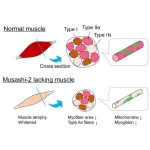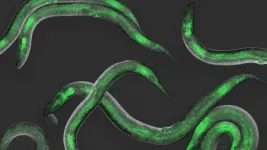Scientists set sights on protein that controls skeletal muscle composition
Musashi-2 found to regulate type 2a muscle fiber mass and metabolism
2023-09-09
(Press-News.org)
Tokyo, Japan – Researchers from Tokyo Metropolitan University have shown that the protein Musashi-2 (Msi2) plays a key role in the regulation of mass and metabolic processes in skeletal muscle. They studied mice with the Msi2 gene knocked out and found reduced muscle mass due to fewer type 2a muscle fibers. Myoglobin and mitochondria were also reduced. Type 2a fibers respond sensitively to training and illnesses; insights into their regulation will prove valuable in new therapies.
Skeletal muscle fibers are truly fascinating in how responsive they are. With training, we can significantly improve muscle mass, strength and endurance. On the other hand, with age or extended periods without exercise, muscle can also atrophy. Not only is that bad for getting around but can cause a whole host of other illnesses. Yet the exact mechanism by which muscle mass and strength are regulated is still not fully understood by scientists.
Now, a team led by Assistant Professor Yasuro Furuichi from Tokyo Metropolitan University have emerged with a key part of the puzzle. In previous work, they found that Musashi-2 (Msi2), a protein originally discovered in nerve cells, was also expressed in skeletal muscle tissue. Muscular atrophy also led to a decrease in the expression of Msi2. Suspecting that Msi2 had a more specific role in the development of muscle fibers, they decided to take a closer look.
Firstly, they took muscle tissue from mice and applied enzymes to isolate the muscle fibers from nerves, blood vessels and fat cells. Analysis confirmed that Msi2 was indeed being expressed from the muscle fibers themselves. Furthermore, on looking at fibers taken from calf muscles, they found Msi2 was most strongly expressed in type 1 or “slow” fibers, fibers with more endurance but less explosive power than their type 2 or “fast” counterparts.
The team also looked at mice with the gene coding for the Musashi-2 protein artificially “knocked out”. They found that the calf muscles of Msi2 knockout mice had significantly reduced mass, with a whitish color, and less strength. On looking at fiber types under a microscope, they now found that the reduction in mass was due to a drop in the number of type 2a fibers, a type of “fast” fiber that has some of the endurance of “slow” fibers. They also noted that Msi2 knockout mice were less able to metabolize sugars, much like in diabetes. There were fewer myoglobin and mitochondria, both vital to produce energy in cells. The problem could be “fixed” by expressing Msi2 in “fast” fibers, restoring both myoglobin and protein markers for mitochondria. This highlights how Msi2 regulates proteins associated with sugar metabolism and effectively controls the proportion of different types of fiber in skeletal muscle tissue.
Type 2a fibers are particularly responsive to training and atrophy easily with age. This makes any insights into how they are regulated a key advance in identifying targets for new therapies to combat muscle decline, as well as developing training regimens to improve muscle strength.
This work was supported by the FOREST Program of the Japan Science and Technology Agency (Grant no. JPMJFR205K), a Tokyo Metropolitan Government Advanced Research Grant [R2-2] and a TMU Strategic Research Fund for Innovative Research Project [R3].
END
ELSE PRESS RELEASES FROM THIS DATE:
2023-09-09
One radiologist supported by AI detected more cases of breast cancer in screening mammography than two radiologists working together, reports the ScreenTrustCAD study from Karolinska Institutet in The Lancet Digital Health. The researchers say that AI is now ready to be implemented in breast cancer screening.
For over 30 years, screening mammography has been an important key in reducing breast cancer mortality rates. However, challenges include a lack of radiologists and that not all cancers are detected. Several retrospective studies have shown that artificial ...
2023-09-09
ROCHESTER, Minn. — In a randomized trial, published in The Lancet Oncology, Mayo Clinic Comprehensive Cancer Center researchers uncover evidence supporting a shorter treatment time for breast cancer patients. The study compared two separate dosing schedules of pencil-beam scanning proton therapy, the most advanced type of proton therapy known for its precision in targeting cancer cells while preserving healthy tissue to reduce the risk of side effects.
Survival rates for breast cancer continue to improve due to advances in diagnosis and treatment, leading to increasing emphasis on reducing the long-term ...
2023-09-09
A University of Texas at Arlington hydrologist’s study in the Nature journal Scientific Data provides the first-ever global estimate of human destruction of natural floodplains. The study can help guide future development in a way that can restore and conserve vital floodplain habitats that are critical to wildlife, water quality and reducing flood risk for people.
Adnan Rajib, a UT Arlington assistant professor in the Department of Civil Engineering, was the lead author on the published study, “Human Alterations of the Global Floodplains.” His doctoral student, Qianjin Zheng, played a significant ...
2023-09-08
Images
Researchers at Michigan State University have shown that table salt outperforms other expensive catalysts being explored for the chemical recycling of polyolefin polymers, which account for 60% of plastic waste.
The research, published in the journal Advanced Sustainable Systems, shows that sodium chloride could provide a safe, inexpensive and reusable way to make plastics more recyclable.
The team also showed that table salt and other catalysts could be used in the recycling of metallized plastic films — like ...
2023-09-08
FINDINGS
In a recent study led by Lei Jiang, Ph.D., an assistant professor of molecular and cellular endocrinology, a team of researchers from City of Hope and the University of Texas Southwestern Medical Center, found a potential new target for treating patients with metastatic cancer. Their findings were published in the August 29 issue of the journal Cell Reports.
The goal of the team’s study was to elucidate the role of reductive carboxylation in redox metabolism, a process believed to be important for metastatic cancer. Reductive carboxylation is best known as a metabolic pathway that provides a molecule called acetyl-CoA so that it can be turned into lipids, which ...
2023-09-08
A three-year, $3.4 million grant to investigate how Alzheimer’s disease is connected to multiple chronic diseases has been awarded to UTHealth Houston researchers by the National Institute on Aging, part of the National Institutes of Health.
To study this, a team led by Xiaoqian Jiang, PhD, principal investigator and professor and chair in the Department of Health Data Science and Artificial Intelligence with McWilliams School of Biomedical Informatics at UTHealth Houston, will build risk trajectory maps for patients using clinical data and electronic health records. Specifically, they will develop electronic health records ...
2023-09-08
September 8, 2023 – SwiftPharma, a Belgium-based manufacturer, and the Population Council, a global nonprofit research organization, have signed a Manufacturing Master Service Agreement for the plant-based manufacture of Griffithsin to further the Council’s development of a Griffithsin fast-dissolving vaginal insert for protection against HIV.
The Population Council has been developing a non-antiretroviral HIV-prevention method containing Griffithsin (GRFT) in a fast-dissolving insert (FDI). This Griffithsin FDI is an on-demand, user-controlled, portable prevention technology in early development ...
2023-09-08
Safety-net hospitals have a common mission to provide care for Medicaid beneficiaries and those who are uninsured, but there’s no universal definition for these hospitals—complicating efforts to allocate funding.
In a new analysis published in JAMA Network Open and led by researchers at the NYU School of Global Public Health, the research team looked at five established definitions for safety-net hospitals and found that different criteria captured varying hospitals and characteristics. As a result, when the Centers for Medicaid and Medicare Services (CMS) use one definition ...
2023-09-08
The world saw another year full of extreme weather events resulting from climate change in 2022, from intense storms to soaring temperatures and rising sea levels. Antarctica was no exception, according to new research published this week.
In the 33rd annual State of the Climate report, an international assessment of the global climate published Sept. 6 in the Bulletin of the American Meteorological Society, CU Boulder researchers report that the planet’s coldest and driest continent experienced both an unprecedented heatwave and extreme precipitation last year.
“My hope is that the public starts to see both the fragility and complexity of these ...
2023-09-08
There’s a rhythm to developing life. Growing from a tiny cell cluster into an adult organism takes precise timing and control. The right genes must turn on at the right time, for the right duration, and in the correct order. Losing the rhythm can lead to diseases like cancer. So, what keeps every gene on beat?
Cold Spring Harbor Laboratory (CSHL) Professor Christopher Hammell has found that in the worm C. elegans, this genetic orchestra has no single conductor. Instead, a quartet of molecules works in concert to time each developmental stage. Hammell says this process shares some similarities with the circadian clocks that control human ...
LAST 30 PRESS RELEASES:
[Press-News.org] Scientists set sights on protein that controls skeletal muscle composition
Musashi-2 found to regulate type 2a muscle fiber mass and metabolism







